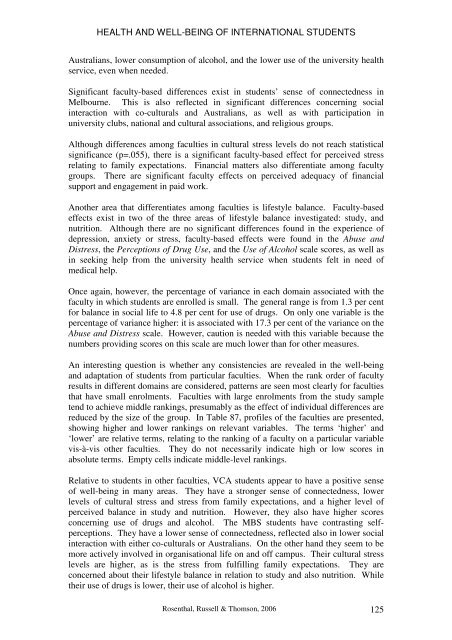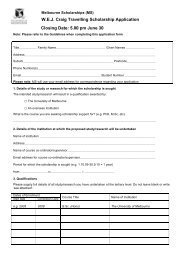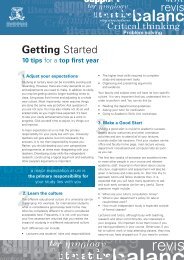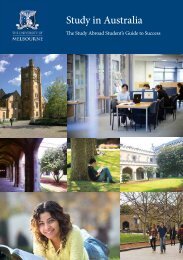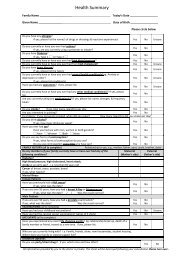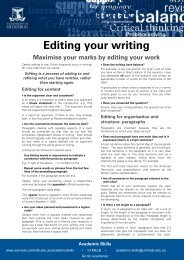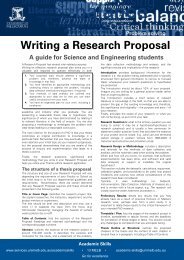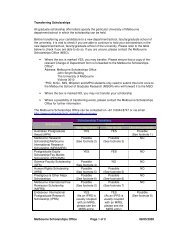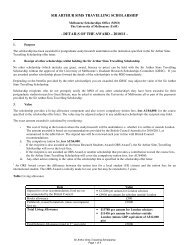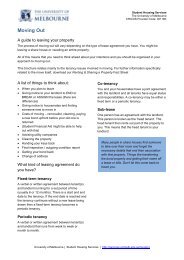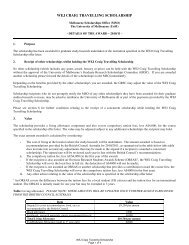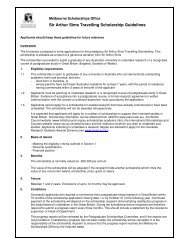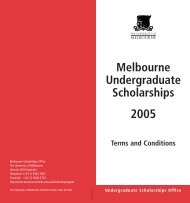a growing experience - Student Services - University of Melbourne
a growing experience - Student Services - University of Melbourne
a growing experience - Student Services - University of Melbourne
Create successful ePaper yourself
Turn your PDF publications into a flip-book with our unique Google optimized e-Paper software.
HEALTH AND WELL-BEING OF INTERNATIONAL STUDENTSAustralians, lower consumption <strong>of</strong> alcohol, and the lower use <strong>of</strong> the university healthservice, even when needed.Significant faculty-based differences exist in students’ sense <strong>of</strong> connectedness in<strong>Melbourne</strong>. This is also reflected in significant differences concerning socialinteraction with co-culturals and Australians, as well as with participation inuniversity clubs, national and cultural associations, and religious groups.Although differences among faculties in cultural stress levels do not reach statisticalsignificance (p=.055), there is a significant faculty-based effect for perceived stressrelating to family expectations. Financial matters also differentiate among facultygroups. There are significant faculty effects on perceived adequacy <strong>of</strong> financialsupport and engagement in paid work.Another area that differentiates among faculties is lifestyle balance. Faculty-basedeffects exist in two <strong>of</strong> the three areas <strong>of</strong> lifestyle balance investigated: study, andnutrition. Although there are no significant differences found in the <strong>experience</strong> <strong>of</strong>depression, anxiety or stress, faculty-based effects were found in the Abuse andDistress, the Perceptions <strong>of</strong> Drug Use, and the Use <strong>of</strong> Alcohol scale scores, as well asin seeking help from the university health service when students felt in need <strong>of</strong>medical help.Once again, however, the percentage <strong>of</strong> variance in each domain associated with thefaculty in which students are enrolled is small. The general range is from 1.3 per centfor balance in social life to 4.8 per cent for use <strong>of</strong> drugs. On only one variable is thepercentage <strong>of</strong> variance higher: it is associated with 17.3 per cent <strong>of</strong> the variance on theAbuse and Distress scale. However, caution is needed with this variable because thenumbers providing scores on this scale are much lower than for other measures.An interesting question is whether any consistencies are revealed in the well-beingand adaptation <strong>of</strong> students from particular faculties. When the rank order <strong>of</strong> facultyresults in different domains are considered, patterns are seen most clearly for facultiesthat have small enrolments. Faculties with large enrolments from the study sampletend to achieve middle rankings, presumably as the effect <strong>of</strong> individual differences arereduced by the size <strong>of</strong> the group. In Table 87, pr<strong>of</strong>iles <strong>of</strong> the faculties are presented,showing higher and lower rankings on relevant variables. The terms ‘higher’ and‘lower’ are relative terms, relating to the ranking <strong>of</strong> a faculty on a particular variablevis-à-vis other faculties. They do not necessarily indicate high or low scores inabsolute terms. Empty cells indicate middle-level rankings.Relative to students in other faculties, VCA students appear to have a positive sense<strong>of</strong> well-being in many areas. They have a stronger sense <strong>of</strong> connectedness, lowerlevels <strong>of</strong> cultural stress and stress from family expectations, and a higher level <strong>of</strong>perceived balance in study and nutrition. However, they also have higher scoresconcerning use <strong>of</strong> drugs and alcohol. The MBS students have contrasting selfperceptions.They have a lower sense <strong>of</strong> connectedness, reflected also in lower socialinteraction with either co-culturals or Australians. On the other hand they seem to bemore actively involved in organisational life on and <strong>of</strong>f campus. Their cultural stresslevels are higher, as is the stress from fulfilling family expectations. They areconcerned about their lifestyle balance in relation to study and also nutrition. Whiletheir use <strong>of</strong> drugs is lower, their use <strong>of</strong> alcohol is higher.Rosenthal, Russell & Thomson, 2006 125


